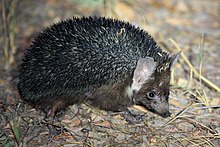| This article needs additional citations for verification. Please help improve this article by adding citations to reliable sources. Unsourced material may be challenged and removed. Find sources: "Brandt's hedgehog" – news · newspapers · books · scholar · JSTOR (November 2019) (Learn how and when to remove this message) |
| Brandt's hedgehog | |
|---|---|

| |
| Conservation status | |
 Least Concern (IUCN 3.1) | |
| Scientific classification | |
| Domain: | Eukaryota |
| Kingdom: | Animalia |
| Phylum: | Chordata |
| Class: | Mammalia |
| Order: | Eulipotyphla |
| Family: | Erinaceidae |
| Genus: | Paraechinus |
| Species: | P. hypomelas |
| Binomial name | |
| Paraechinus hypomelas (Brandt, 1836) | |

| |
| Brandt's hedgehog range | |
Brandt's hedgehog (Paraechinus hypomelas) is a species of desert hedgehog native to parts of the Middle East and Central Asia. Its common name derives from its having first been described by Johann Friedrich von Brandt, a director of the Zoological Department at the St Petersburg Academy of Sciences.
Description
Brandt's hedgehog is approximately the size of the West European hedgehog (about 500–1,000 g (18–35 oz) in weight and 25 cm (9.8 in) in length), but has distinctively large ears (similar to the long-eared hedgehog), and is a much faster runner, due to lighter needle protection. Unlike the long-eared hedgehog, however, it is predominantly nocturnal.
The first and only study of the Brandt's hedgehog histological skin characteristics found three layers of skin the epidermis, dermis and hypodermis; while previous studies of other hedgehogs sited only two.
Habitat
Brandt's hedgehog prefers arid desert areas and mountains. It often uses natural shelter, although it is still capable of digging dens when absolutely needed. It hibernates during colder weather.
References
- Bhattacharyya, T.; Srinivasulu, C.; Molur, S. (2017) . "Paraechinus hypomelas". IUCN Red List of Threatened Species. 2016: e.T40610A115174910. doi:10.2305/IUCN.UK.2016-3.RLTS.T40610A22326573.en. Retrieved 4 March 2022.
- Hutterer, R. (2005). Wilson, D.E.; Reeder, D.M. (eds.). Mammal Species of the World: A Taxonomic and Geographic Reference (3rd ed.). Johns Hopkins University Press. p. 217. ISBN 978-0-8018-8221-0. OCLC 62265494.
- Bazm, M. Akbari; Goodarzi, N.; Abumandour, M. M. A.; Naseri, L.; Hosseinipour, M. (2020). "Histological characterisation of the skin of the Paraechinus hypomelas, Brandt, 1836 (Erinaceidae: Eulipotyphla)". Folia Morphologica. 79 (2): 280–287. doi:10.5603/FM.a2019.0076. ISSN 1644-3284. PMID 31313824.
- Abe, Yoshinori; Tanaka, Nobuyuki (2017-11-20). "Roles of the Hedgehog Signaling Pathway in Epidermal and Hair Follicle Development, Homeostasis, and Cancer". Journal of Developmental Biology. 5 (4): 12. doi:10.3390/jdb5040012. ISSN 2221-3759. PMC 5831796. PMID 29615568.
| Extant Erinaceidae species by subfamily | |||||||||||||
|---|---|---|---|---|---|---|---|---|---|---|---|---|---|
| |||||||||||||
| Erinaceinae (Hedgehogs) |
| ||||||||||||
| Galericinae (Gymnures) |
| ||||||||||||
| Taxon identifiers | |
|---|---|
| Paraechinus hypomelas | |
| Erinaceus hypomelas | |
 | This Erinaceidae article is a stub. You can help Misplaced Pages by expanding it. |